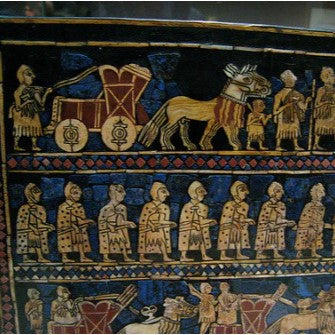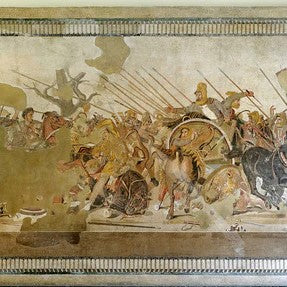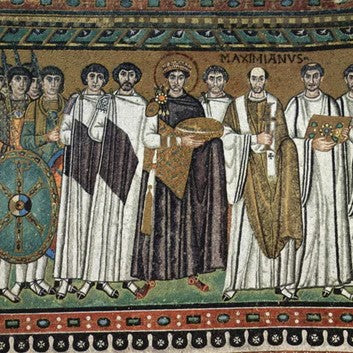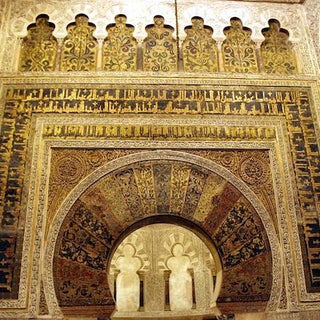History of Mosaic

his week, local artist Colleen Patricia Williams educates us about the rich history of her artistic medium--mosaics.

Mosaic is an art form that is at least 4000 years old and originated in Mesopotamia, with bits of colored stones, glass and other materials. Mosaic also had a version that used terracotta cones, with the points pushed into clay to create a decorative surface. The Greeks used pebbles to create decorations.

Detail of The Standard of Ur, Mesopotamia Mosaic, 2600-2400 BC
Mosaic developed even further with the Greeks, who took the stones and pebbles and turned them into even more intricate designs, but mosaics really reached their ancient glory with the Romans, in Africa and Syria, the wealthiest Roman provinces. Beautiful floors have been found in Herculaneum and Pompeii. The mosaics in the Roman Empire featured domestic scenes, geometric designs and depictions of the gods in their pantheon. The lowest quality mosaics in the Roman Empire were to be found in Britain since not many mosaic artists were to be found at the farthest reaches of the empire.

Alexander Mosaic; Pompeii, c. 100 BC
The first glazed mosaic tiles were found in Susa, in what is modern day Iran, around 1500 BCE. Mosaics spread into Macedonia, into Carthage, then Rome.
The development of tesserae, a manufactured tile that was capable of great variation in color, size and shape that made great detail as well as subtle color changes possible. Sometimes these tesserae were very tiny pieces, allowing the artist to paint with tile.
The development of tesserae, a manufactured tile that was capable of great variation in color, size and shape that made great detail as well as subtle color changes possible. Sometimes these tesserae were very tiny pieces, allowing the artist to paint with tile.
After the fall of the Roman Empire, mosaics in the Byzantine era went from mainly floor decorations to beautiful and intricate wall pieces that depicted religious subjects. This is also where we see the development of a new type of tile called “smalti”. Smalti tiles are made of glass, with the inclusions of air bubbles and they are often backed with silver foil or gold leaf. This gives the tiles a depth and beauty that just glows.

Mosaic icon of the Virgin Episkepsis, Constantinople, late 13th century
There are many interesting things about the Byzantine mosaics; that they were mostly ungrouted, in order to allow light to reflect off of edges. Also, the smalti tiles were set at a slight angle in order to catch the light reflections from different angles. This resulted in sparkling mosaics no matter what view they were seen by viewers.
In the 5th century, the city of Ravenna became known as the city of mosaics. The best known building in the city is the mausoleum of Theodoric, a king of Byzantium. The best known mosaic is the mosaic in the cathedral built for this same king, but now renamed Sant’Apollinaire Nuovo. The scenes in this cathedral featured images of Christ as well as images of Theodoric and his household. Many of those have been replaced by later rulers; interestingly, there is a scene of the Emperor Justinian and the Empress Theodora. This is interesting because the images of Theodoric were removed because the principle of having no images of a ruler in a cathedral.
In the 5th century, the city of Ravenna became known as the city of mosaics. The best known building in the city is the mausoleum of Theodoric, a king of Byzantium. The best known mosaic is the mosaic in the cathedral built for this same king, but now renamed Sant’Apollinaire Nuovo. The scenes in this cathedral featured images of Christ as well as images of Theodoric and his household. Many of those have been replaced by later rulers; interestingly, there is a scene of the Emperor Justinian and the Empress Theodora. This is interesting because the images of Theodoric were removed because the principle of having no images of a ruler in a cathedral.

Court of Emperor Justinian with (right) archbishop Maximian and (left) court officials and Praetorian Guards; Basilica of San Vitale in Ravenna, Italy. c. 547 A.D.
At the same time, in the Islamic world, mosaics were also developing, with stone and depictions of geometric figures and mathematical principals. The Islamic mosaics often were made according to a technique called “zillij”. Zillij involves creating tiles specifically for the particular project, and then further handworking on each tile to ensure a custom fit that covers the entire surface in a seamless piece. Examples of this can be seen in the Great Mosque in Cordova and the Alhambra.
Mihrab, Great Mosque at Cordoba
Mosaics have come a long way, with a venerable history. Today we use art glass, stones, found objects, whatever makes a piece work. With the new products that are out there today, mosaics have a great future ahead of them!
You can reach our previous article from https://www.artmasterclass.com.au/blogs/news/history-of-turkish-lamps
References
http://www.thejoyofshards.co.uk/history/
http://www.ancient.eu/Mosaic/
http://www.historyworld.net/wrldhis/PlainTextHistories.asp?ParagraphID=eiq
http://www.ancient.eu/Mosaic/
http://www.historyworld.net/wrldhis/PlainTextHistories.asp?ParagraphID=eiq





